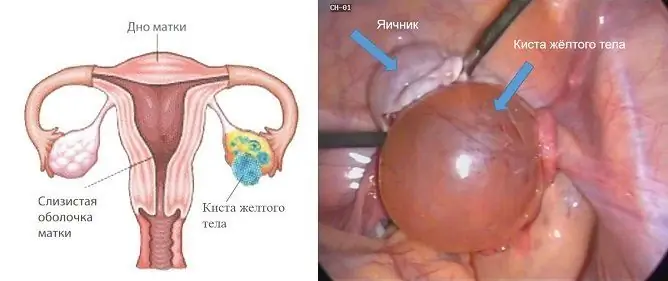- Author Rachel Wainwright [email protected].
- Public 2023-12-15 07:39.
- Last modified 2025-11-02 20:14.
Cyst
The content of the article:
- Causes and risk factors
- Forms
- Symptoms
- Diagnostics
- Treatment
- Potential consequences and complications
- Forecast
- Prevention
A cyst is a cavity that forms in tissues and organs as a result of pathological processes, which has walls and contents. The size and structure of the cysts is largely determined by their age, localization, origin. Cystic formations can grow in size over time, and some of them can degenerate into malignant tumors.

Ovarian cyst
Causes and risk factors
Cysts are congenital and acquired. The reason for the formation of congenital cysts is improper formation of tissues and organs at the stage of intrauterine development of the fetus. Various factors can lead to this, for example, infectious diseases of a pregnant woman, exposure to ionizing radiation during pregnancy, or taking medications that have a teratogenic effect.
Acquired cysts are usually caused by infectious processes or trauma, as a result of which a particular duct in the body is blocked.
Forms
Based on the characteristics of the histological structure of the wall, cysts are divided into two groups:
- true (lined with epithelial cells);
- false (do not have an epithelial lining).

Multiple simple kidney cysts
According to the pathological mechanism of formation, the following forms of cysts can be distinguished:
- Retention. Usually localized in the iron secretory tissue (prostate, pancreas, mammary, salivary and sebaceous glands). Acquired retention cysts are formed as a result of compression of the duct of the gland by a scar, tumor, its overlap with a plug of thickened secretion or calculus. Congenital develops as a result of atresia (overgrowth) of the duct of the gland.
- Ramolitic. Formed as a result of hemorrhage in a compact tissue, followed by necrosis of the focus and its resorption. These include cystic formations of the brain and spinal cord, dental cysts, cysts of the corpus luteum of the ovary, bone cysts against the background of osteitis fibrosus, osteoblastomas, as well as cysts that form in the thickness of malignant tumors.
- Parasitic. These include cysticercous and echinococcosis cysts, which are the body of a parasite surrounded by a membrane.
- Traumatic. Formed when soft tissue is damaged, usually localized in the iris of the eyes, hands, in the liver, pancreas.
- Dysontogenetic. They arise in the early stages of embryo development as a result of improper tissue formation and organ budding, that is, they are congenital. Often they contain the rudiments of organs (teeth, hair). These include: cysts of the brain, lungs and pancreas, multiple kidney cysts (polycystic), dermoid and paraovarian cysts.
- Tumor. They can be single or multi-chamber. Cavities are formed by developing tumor tissue in the process of carcinogenesis or as a result of metabolic disorders. This type of cyst is characteristic of glandular organs (cystic amelobastoma, cystic lymphangioma, cystic adenoma of the salivary gland).
Symptoms
With a small size of cystic formation, the disease is almost asymptomatic. As the cyst grows, it begins to put pressure on the surrounding organs, which is manifested by the appearance of signs characteristic of the pathology of a particular organ. For example, symptoms of an ovarian cyst are:
- lower abdominal pain;
- menstrual irregularities;
- painful menstruation.

Ovarian cyst is manifested by pain in the lower abdomen
A kidney cyst has manifestations similar to those of pyelonephritis:
- increased blood pressure;
- disorders of urination;
- dull aching pain in the lower back.
Diagnostics
Diagnosis of a cyst is based on data from the clinical picture, history, medical examination and the results of laboratory and instrumental examination, including:
- ultrasound procedure;
- computed or magnetic resonance imaging;
- radiography;
- clinical analyzes of blood and urine;
- biochemical blood test;
- determination of tumor markers in the blood.

Cysts are clearly visible on ultrasound
Treatment
Therapeutic tactics are determined by the nature of the cystic formation, its localization, size, age of the patient, his general condition, the presence of concomitant pathology.
With hormonal ovarian cysts, long-term therapy with oral contraceptives is performed. In other cases, cysts are surgically removed.

Ovarian cyst responds well to oral contraceptive therapy
With parasitic cysts in the postoperative period, patients must be prescribed antiparasitic drugs to prevent a relapse of the disease.
Potential consequences and complications
Some cysts may become malignant over time, i.e., degenerate into a malignant tumor.
Cysts on the leg are dangerous in terms of complications. With good mobility, they are able to twist. When the legs are twisted, the vessels supplying the cyst wall are compressed, and its necrosis develops.
Parasitic cysts can rupture spontaneously, as a result of which anaphylactic shock can develop, and parasites can become infected with other organs and tissues.
Forecast
With timely diagnosis and adequate treatment of cystic formations, the prognosis in most cases is favorable.
Prevention
There is no specific prophylaxis aimed at preventing cyst formation.
YouTube video related to the article:

Elena Minkina Doctor anesthesiologist-resuscitator About the author
Education: graduated from the Tashkent State Medical Institute, specializing in general medicine in 1991. Repeatedly passed refresher courses.
Work experience: anesthesiologist-resuscitator of the city maternity complex, resuscitator of the hemodialysis department.
The information is generalized and provided for informational purposes only. At the first sign of illness, see your doctor. Self-medication is hazardous to health!






